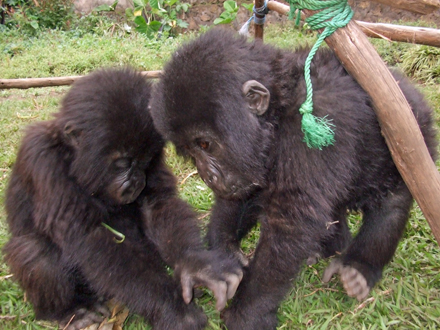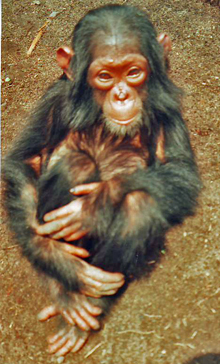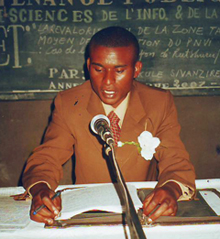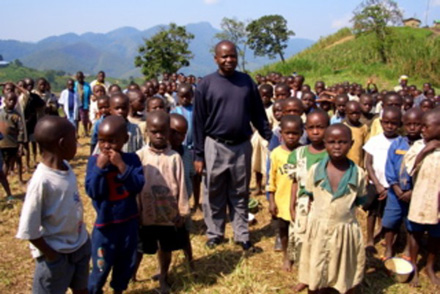Navigation
UN Action Plan Year of the Gorilla Boosts Goals of Tayna Gorilla Reserve in Congo
Five years ago, Kakule Vwirasihikya's and his colleagues’ established the 225,000-acre Tayna Gorilla Reserve which protects gorillas, elephants, and leopards while providing many locals with jobs and education. Its community college, Tayna Center for Conservation Biology (TCCB), proudly announced on January 8, 2009, that it now has 220 graduates in natural resource management and conservation.
 |
| Baby Gorillas at the Tayna Gorilla Reserve Kakule Vwirasihikya said: “ Our project of protecting gorillas, which started a decade ago in a so critical period of wars in the east of the Democratic Republic of Congo, is now very impressive. All stakeholders in our communities are now very involved in it. The customary chiefs, who are very active in the project instill their daughters and sons with community conservation as the best way to protect their biodiversity.”Photo TCCB |
Five years ago, Kakule Vwirasihikya's and his colleagues’ established the 225,000-acre Tayna Gorilla Reserve which protects gorillas, elephants, and leopards while providing many locals with jobs and education. Its community college, Tayna Center for Conservation Biology (TCCB), proudly announced on January 8, 2009, that it now has 220 graduates in natural resource management and conservation.
“The idea of conservation of nature had been considered utopian by the local community who believed that it was only a government task to conserve nature,” said Kakule. “Some other people were even skeptical of the creation of the Tayna Gorilla Reserve’s college, TCCB. It is a university for conservation studies based in Kasugho, a remote village in the east of the Democratic Republic of the Congo (DRC).”
 |
| Baby Chimp Photo TCCB |
“It was with strong determination that the group of community-based reserves TCCB, supported by its partners Dian Fossey Gorilla Fund International (DFGF-I) and the Conservation International (CI), among others, pursued its mission and has reached so many achievements that today all those people who were so pessimistic at first simply say ‘ We could not believe it ! Anyway, Congratulations! Go ahead!’ ”
“We hear such exclamations when people learn the facts. For example, they are excited to hear that so many students are completing their studies at TCCB and ready to serve usefully their communities for better management of their biodiversity,” Kakule said.
 |
| Kakule Sivanzire a student at the Tayna Center for Conservation Biology ( TCCB ) university defending his research paper in September 2008 in order to obtain a degree in Information and environmental communication. Kakule said that he is very proud of his updated education in techniques he can now use to report on conservation and share information about conservation actions for the welfare of his community. Photo TCCB. |
With the help of the students and graduates people in villages near TCCB have come to appreciate how they can help save gorillas and also benefit themselves. “People have really changed their mind in favour of conservation thanks to sensitisation TCCB provides to them through the teaching of conservation in classes, through Tayna community radio and through the TCCB students’ club ‘Amis des Gorilles,’” Kakule says.
 |
| Kakule Vwirasihikya with students. |
Kakule says that this community is ready to denounce people who are engaged in poaching activities. They sometimes confiscate primates from people trafficking them and bring these animals to TCCB where a center for rehabilitation of orphan gorillas is to be built. This center, the first in the east of Africa, is situated not far from Tayna Gorilla Reserve where these young gorillas, once rehabilitated, will likely be reintroduced.
Earlier articles on the reserve published on the Horizon Solutions Site are :
Congo Gorilla Reserve Helps People
A Profile on Gorilla Conservation by Young Journalists on the Solutions-Site for Kids
Tayna Gorilla Reserve Brings Communities and Orphans Together to Save Wildlife
Another on gorillas on the Solutions Site is:
Saving King Kong: UNEP and Partners Work to Save Gorillas
"The Tayna Center for Conservation Biology is training the next generation of conservationists in the Congo and is the nation's only community-run conservation university." Conservational International presents a video which was uploaded to YouTube by ConservationDotOrg on Jun 3, 2008. Decades of war have had a devastating effect on the Congo region. Not only the people of this region, but the gorillas and the habitat on which they rely. Learn more at: http://www.conservation.org/Campaigns/Lost_There_Felt_Here/
The following is the UN Announcement:
Africa-wide UN action plan seeks to save the gorilla
The Year of the Gorilla is a joint initiative of UNEP-CMS, the UNEP/UN Educational, Scientific and Cultural Organization's Great Ape Survival Partnership (GRASP) and the World Association of Zoos and Aquariums (WAZA). It was announced on 1 December 2008. The following is the announcement from the UN News.
Low-volume wood-burning stoves to protect forest habitat, alternative livelihoods to replace bush meat hunting with beekeeping and the promotion of ecotourism are among steps planned under the United Nations Year of the Gorilla 2009, launched today, to save of one of humankind’s closest but critically endangered relatives.
Many experts are warning that without urgent action gorillas will become extinct in the wild within the next few decades and the Year, launched at the opening of a UN wildlife conference in Rome by Prince Albert II of Monaco, aims to boost protection of the great ape and its habitat by increasing the livelihoods and incomes of local people from managing their conservation.
“Flagship species such as the gorilla can be a powerful catalyst for improved conservation and the more intelligent management of economically-important ecosystems,” UN Environment Programme (UNEP) Executive Director Achim Steiner said.
“In doing so, initiatives such as the Year of the Gorilla can galvanize and revitalize action on the ground, [which is] so urgently needed to reverse the rate of loss of biodiversity while generating incomes and improving livelihoods for local people and communities.”
The action plan includes a range of projects available for backing by governments, business, civil society groups and individuals. For example, tests in the Democratic Republic of the Congo (DRC) have found that locally made ‘rocket stoves’ can cut charcoal and wood use by up to 70 per cent. Expanding use to thousands of homes in the region could help reduce pressure on gorilla forest habitat, boost incomes and livelihoods for local people and improve air quality in local homes.
A second pilot project, this time in Cameroon, is boosting alternative livelihoods to reduce commercial hunting of bush meat and the Year of Gorilla plans to expand the ‘Apiarists for the Apes’ (an apiarist is a beekeeper) programme to more communities.
Rwanda and Uganda, with their populations of mountain gorillas, generate significant economic returns from ape-based ecotourism. The industry has surpassed coffee and tea as Rwanda’s number one foreign exchange earner. It is planned to dispatch guides and operators from successful ecotourism programmes in East Africa to countries such as Gabon to boost ecotourism initiatives in West Africa.
Three of the four gorilla species are listed as ‘critically endangered’ on the International Union for the Conservation of Nature (IUCN) Red List, putting them at risk of extinction. Mountain gorillas in DRC, Rwanda and Uganda and the Cross River gorilla in Cameroon and Nigeria number only 700 and 300 respectively. The eastern lowland gorilla in the DRC has plummeted dramatically over the last 10 years with probably only about 5,000 of the formerly 17,000 animals remaining.
The most numerous subspecies, the western lowland gorilla in Angola, the Central African Republic (CAR), Cameroon, DRC, Gabon, Equatorial Guinea and the Republic of Congo, perhaps numbers more than 200,000, but those gorillas remain threatened on several fronts.
The main threats are hunting for food, with at least 1 million tons of bush meat extracted each year from the Congo Basin forests, alongside their use in traditional medicine, capture of live infants as pets and ensnarement in traps set for other species. Habitat loss is being accelerated through logging and slash-and-burn agriculture, while the region’s abundance in natural resources, production of charcoal and mining for gold, zinc, uranium and coltan, an ore used in electronics such as mobile phones, are gradually destroying gorilla habitat.
Moreover, armed conflicts, as in eastern DRC, can trigger the displacement of huge numbers of people who then may use natural resources unsustainably. On top of this, diseases like Ebola can wipe out entire populations.
“Without doubt a special aim of the Year of the Gorilla will be to bring recovery-focused projects to the DRC once hostilities have ceased and community-based conservation projects can be fully resumed,” UNEP Convention on Migratory Species (UNEP-CMS) Executive Secretary Robert Hepworth said.
Ecotourism, sustainable timber harvesting and improved agricultural practices can support reforestation campaigns, anti-poaching efforts and implementation of development projects. One focus will be on the regions bordering areas protected for gorilla conservation. Developmental projects that can also contribute include schools and educational initiatives alongside ones that cover water supplies and health care.
“It is in the interest of the international community and our honourable task to save these unique natural resources and the World Heritage Sites where they live,” Prince Albert said.
Also present at today’s launch was renowned primatologist and Year of the Gorilla 2009 Patron Jane Goodall. “It is time for us to pool all of our resources toward saving these magnificent creatures,” she declared.
Search
Latest articles
Agriculture
- World Water Week: Healthy ecosystems essential to human health: from coronavirus to malnutrition Online session Wednesday 24 August 17:00-18:20
- World Water Week: Healthy ecosystems essential to human health: from coronavirus to malnutrition Online session Wednesday 24 August 17:00-18:20
Air Pollution
- "Water and Sanitation-Related Diseases and the Changing Environment: Challenges, Interventions, and Preventive Measures" Volume 2 Is Now Available
- Global Innovation Exchange Co-Created by Horizon International, USAID, Bill and Melinda Gates Foundation and Others
Biodiversity
- It is time for international mobilization against climate change
- World Water Week: Healthy ecosystems essential to human health: from coronavirus to malnutrition Online session Wednesday 24 August 17:00-18:20
Desertification
- World Water Week: Healthy ecosystems essential to human health: from coronavirus to malnutrition Online session Wednesday 24 August 17:00-18:20
- UN Food Systems Summit Receives Over 1,200 Ideas to Help Meet Sustainable Development Goals
Endangered Species
- Mangrove Action Project Collaborates to Restore and Preserve Mangrove Ecosystems
- Coral Research in Palau offers a “Glimmer of Hope”
Energy
- Global Innovation Exchange Co-Created by Horizon International, USAID, Bill and Melinda Gates Foundation and Others
- Wildlife Preservation in Southeast Nova Scotia
Exhibits
- Global Innovation Exchange Co-Created by Horizon International, USAID, Bill and Melinda Gates Foundation and Others
- Coral Reefs
Forests
- NASA Satellites Reveal Major Shifts in Global Freshwater Updated June 2020
- Global Innovation Exchange Co-Created by Horizon International, USAID, Bill and Melinda Gates Foundation and Others
Global Climate Change
- It is time for international mobilization against climate change
- It is time for international mobilization against climate change
Global Health
- World Water Week: Healthy ecosystems essential to human health: from coronavirus to malnutrition Online session Wednesday 24 August 17:00-18:20
- More than 400 schoolgirls, family and teachers rescued from Afghanistan by small coalition
Industry
- "Water and Sanitation-Related Diseases and the Changing Environment: Challenges, Interventions, and Preventive Measures" Volume 2 Is Now Available
- Global Innovation Exchange Co-Created by Horizon International, USAID, Bill and Melinda Gates Foundation and Others
Natural Disaster Relief
- STOP ATTACKS ON HEALTH CARE IN UKRAINE
- Global Innovation Exchange Co-Created by Horizon International, USAID, Bill and Melinda Gates Foundation and Others
News and Special Reports
- World Water Week: Healthy ecosystems essential to human health: from coronavirus to malnutrition Online session Wednesday 24 August 17:00-18:20
- STOP ATTACKS ON HEALTH CARE IN UKRAINE
Oceans, Coral Reefs
- World Water Week: Healthy ecosystems essential to human health: from coronavirus to malnutrition Online session Wednesday 24 August 17:00-18:20
- Mangrove Action Project Collaborates to Restore and Preserve Mangrove Ecosystems
Pollution
- Zakaria Ouedraogo of Burkina Faso Produces Film “Nzoue Fiyen: Water Not Drinkable”
- "Water and Sanitation-Related Diseases and the Changing Environment: Challenges, Interventions, and Preventive Measures" Volume 2 Is Now Available
Population
- "Water and Sanitation-Related Diseases and the Changing Environment: Challenges, Interventions, and Preventive Measures" Volume 2 Is Now Available
- "Water and Sanitation-Related Diseases and the Changing Environment: Challenges, Interventions, and Preventive Measures" Volume 2 Is Now Available
Public Health
- Honouring the visionary behind India’s sanitation revolution
- Honouring the visionary behind India’s sanitation revolution
Rivers
- World Water Week: Healthy ecosystems essential to human health: from coronavirus to malnutrition Online session Wednesday 24 August 17:00-18:20
- Mangrove Action Project Collaborates to Restore and Preserve Mangrove Ecosystems
Sanitation
- Honouring the visionary behind India’s sanitation revolution
- Honouring the visionary behind India’s sanitation revolution
Toxic Chemicals
- "Water and Sanitation-Related Diseases and the Changing Environment: Challenges, Interventions, and Preventive Measures" Volume 2 Is Now Available
- Actions to Prevent Polluted Drinking Water in the United States
Transportation
- "Water and Sanitation-Related Diseases and the Changing Environment: Challenges, Interventions, and Preventive Measures" Volume 2 Is Now Available
- Urbanization Provides Opportunities for Transition to a Green Economy, Says New Report
Waste Management
- Honouring the visionary behind India’s sanitation revolution
- Honouring the visionary behind India’s sanitation revolution
Water
- Honouring the visionary behind India’s sanitation revolution
- Honouring the visionary behind India’s sanitation revolution
Water and Sanitation
- Honouring the visionary behind India’s sanitation revolution
- Honouring the visionary behind India’s sanitation revolution

